
 |
|
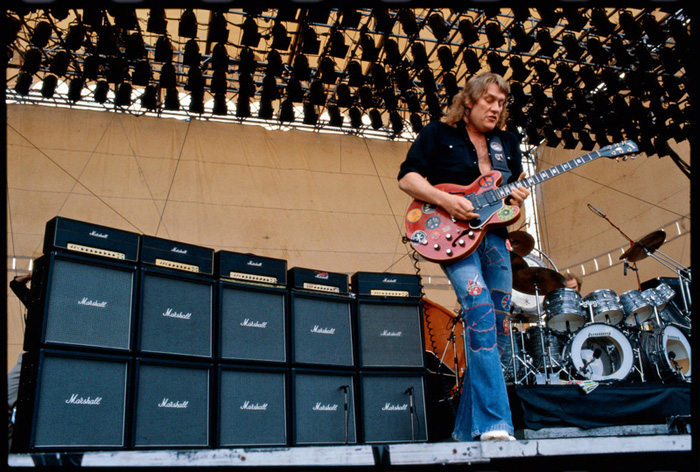
Copyright Herbert Hauke/Rainer Schwanke
GbR
|
|
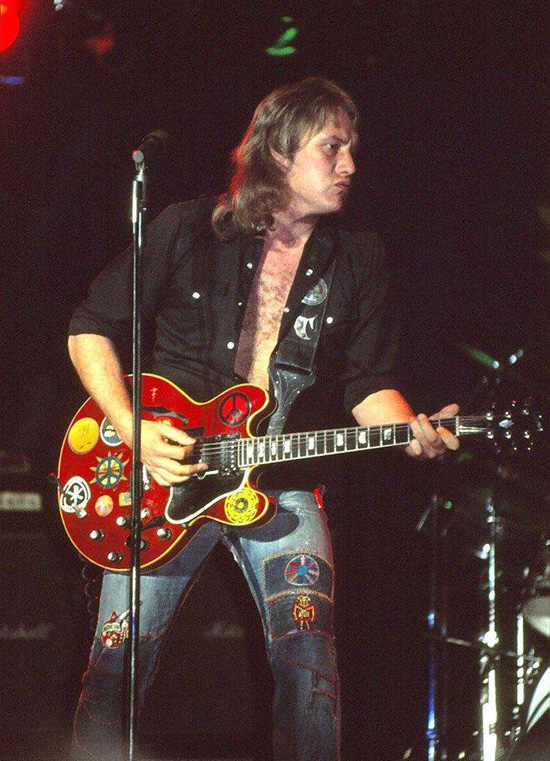
:) JT |
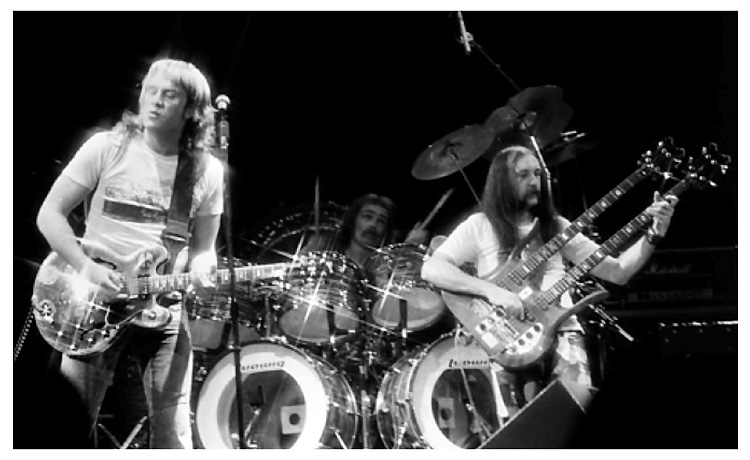 |
| May
15, 1979 - IMA Auditorium, Flint, Michigan - Photo
by Tom Weschler |
Alvin Lee & “Ten Years Later” Tour
Dates 1979
May 26, 1979 -
Miami Florida
May 31, 1979
- The Warehouse, New Orleans
June 1979 – Capitol Theatre, Passaic, New Jersey
June 10, 1979 – Stanley Theatre, Pittsburgh, Pennsylvania
June 15, 1979 – Calderon Concert Hall, Hempstead, Long Island, New
York
June 26, 1979 – Paramount Theatre, Portland, Oregon
June 28, 1979 – Oakland Auditorium, Oakland, California
August 1979 –
Mainz, Germany. Ten Years Later perform “Hey Joe” and
“Ain’t Nothin´ Shakin´” for the “Rock Pop Television
Program”.
August 18, 1979 – Open Air Festival, Saarbrucken, Germany
August 24,
1979 - Winterthur, Switzerland
October 22, 1979 –
Düsseldorf, Germany
October 30, 1979 –
Rock´n Blues Concert in Germany with special guest
star, Louisiana Red.
November 20, 1979
– London, England – Ten Years Later perform “Hey Joe”
on the famous BBC – 2 “Old Grey Whistle Television
Program”.
November 26, 1979
– Odeon, Birmingham
November 27, 1979 – Demontfort
Hall, Leicester, England
November 28, 1979
– Hammersmith Odeon, London, England
November 29, 1979
– City Hall, Newcastle, England
November 30, 1979
– Colston Hall, Bristol, England
|
|
Ten
Years Later - Miami, Florida - May 26, 1979
Photos contributed by HERB STAEHR
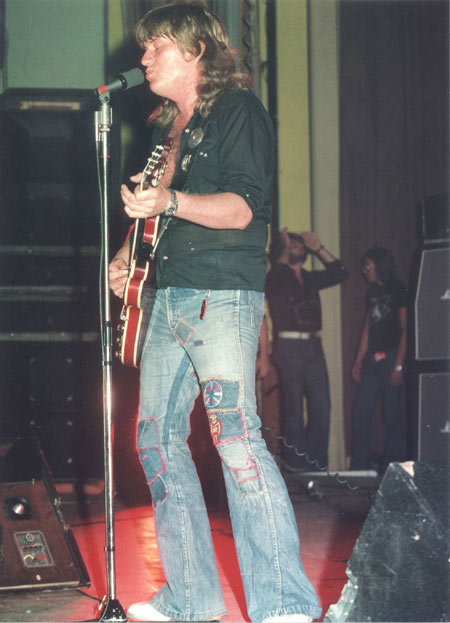
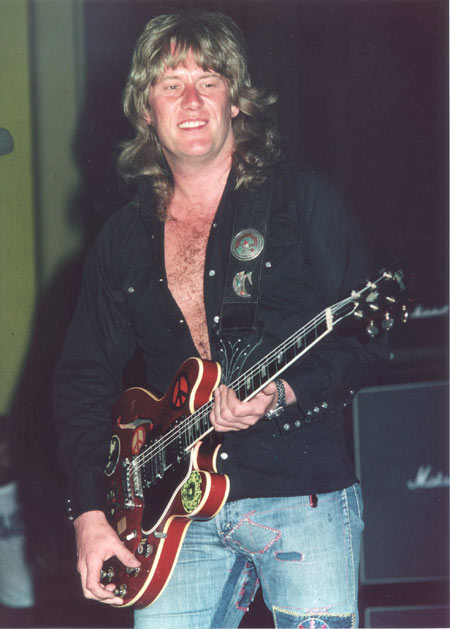
|
|
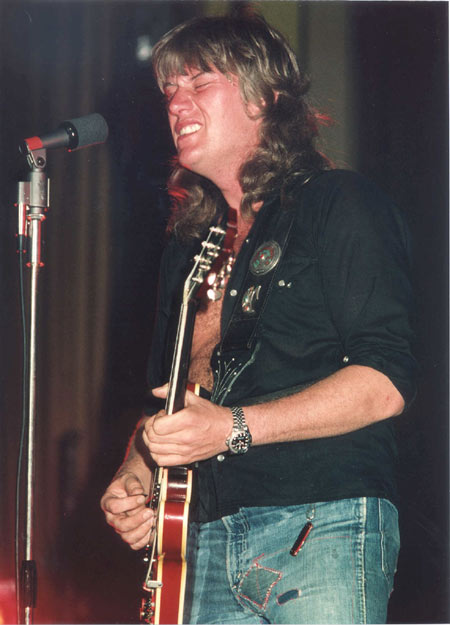
|
|
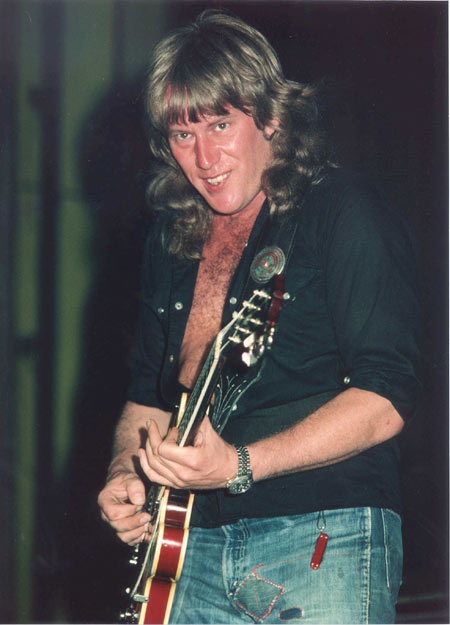
|
|

|
|
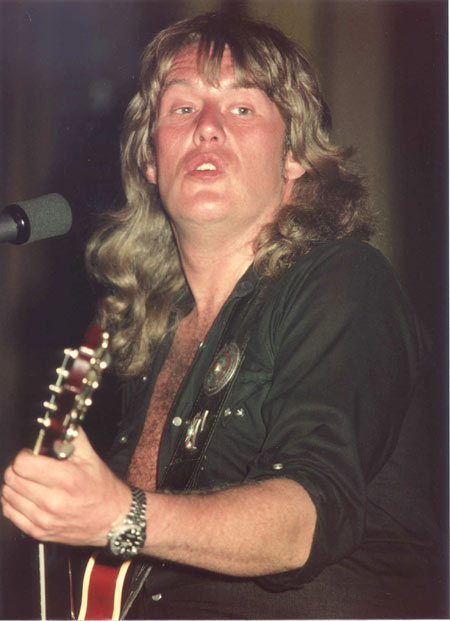
|
|
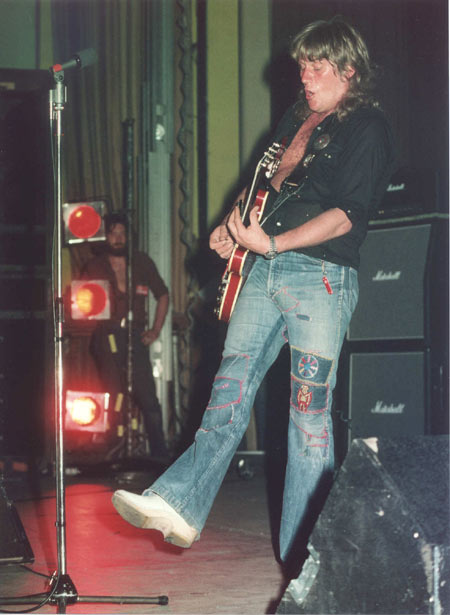
27 May
1979 - CIAO2001, No. 21
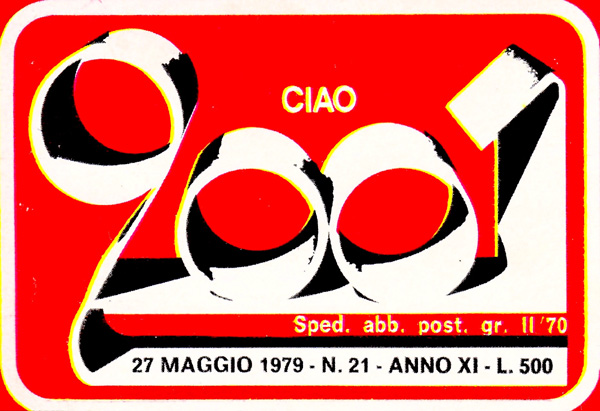
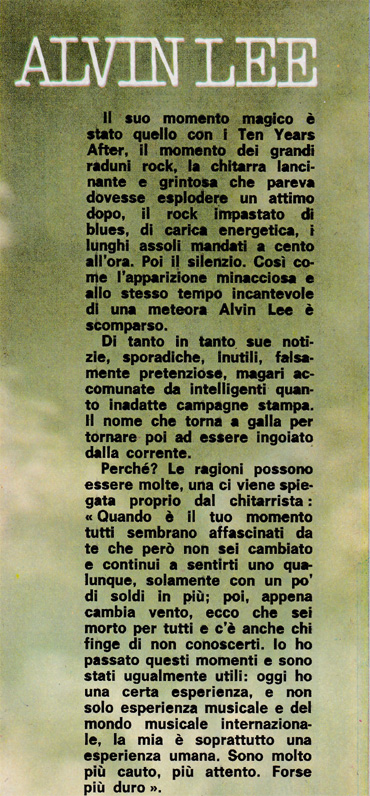
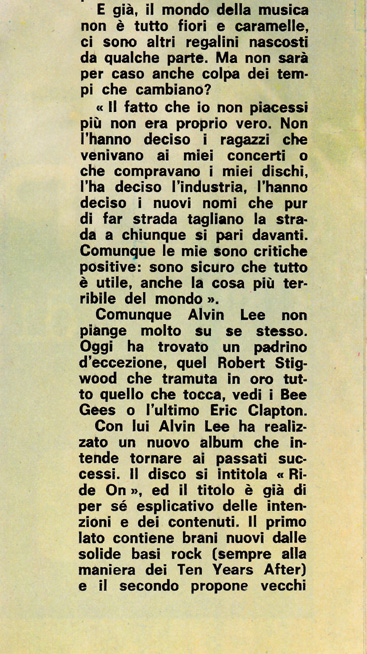
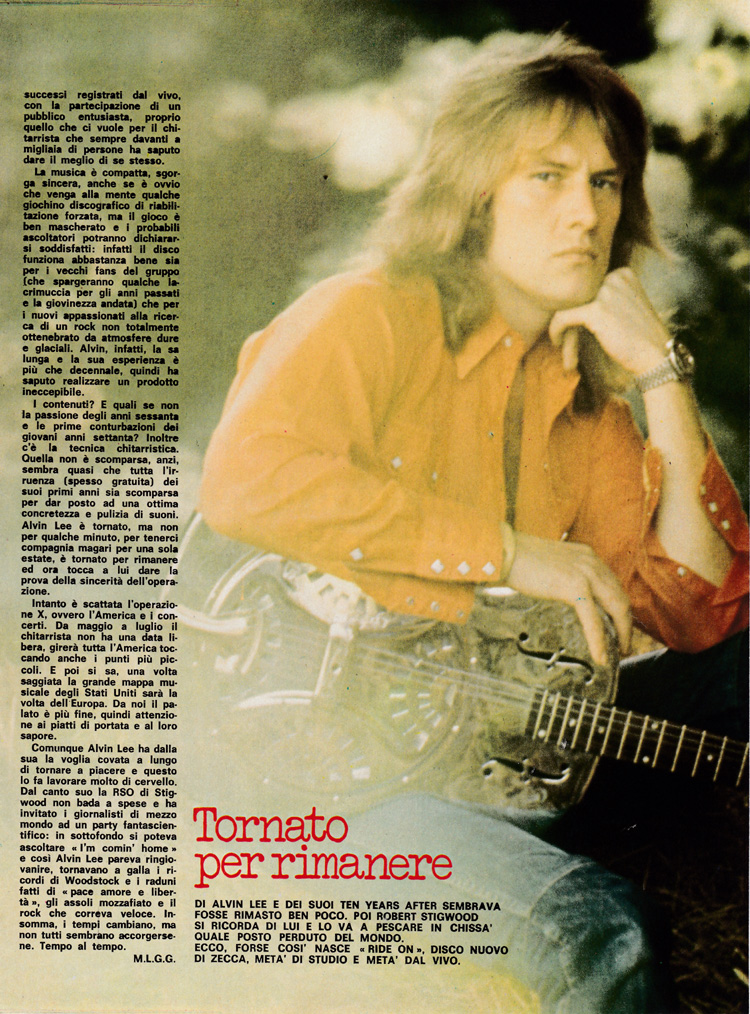
|
THE WAREHOUSE – LARRY’S – Ten
Years Later May 31, 1979

Music notes
from the early 1970’s – So there was the New Orleans
Pop Festival, and while not a super festival, it had
happened in 1969 and a lot of people got turned on
for the first time. More head shops began popping up
around the French Quarter and more long hairs began
showing themselves all around the city, a trend that
had its beginning around 1967 – 1968. As 1970 rolled
around, the next inevitable step was taken, a
concert house was opened up to feature regularly
scheduled rock shows, and featuring some of the best
groups of the time. The venue was simply named, “A
Warehouse” – which was located at 1820 Tchoupitoulas
Street, which was right in the thick of the city’s
old warehouse district, and also right near the
river on the uptown side of Canal Street. The
Warehouse was detached enough to keep neighbourhood
complaints from building up and big enough to house
just about any rock group and its loyal following of
fans.
It was funky
in its make up, the Warehouse carried a warm charm
that made it kind of loose and trippy at the same
time. It was made up of old red brick with old time
wooden rafters on the inside, and concrete floors
that were covered with old carpets, it had a
subterranean underground feel to it. Three sets of
bleachers provided seating against the back and side
walls – this was all before they put in a big bar
area on the one side. The stage and concession area
completed the set up. When the entire place was full
of freaks, you’d almost think that you were in
another world altogether. The “Warehouse” had its
grand opening in late January of 1970, and quite an
auspicious one it was, with The Grateful Dead, Peter
Greens Fleetwood Mac Blues Band, and The Flock, all
playing a two night gig together.
Alvin Lee played there on May 31, 1979 – on the same
bill were Black Oak Arkansas and Blackfoot. |
18
August 1979 - Saarbrücken Open Air
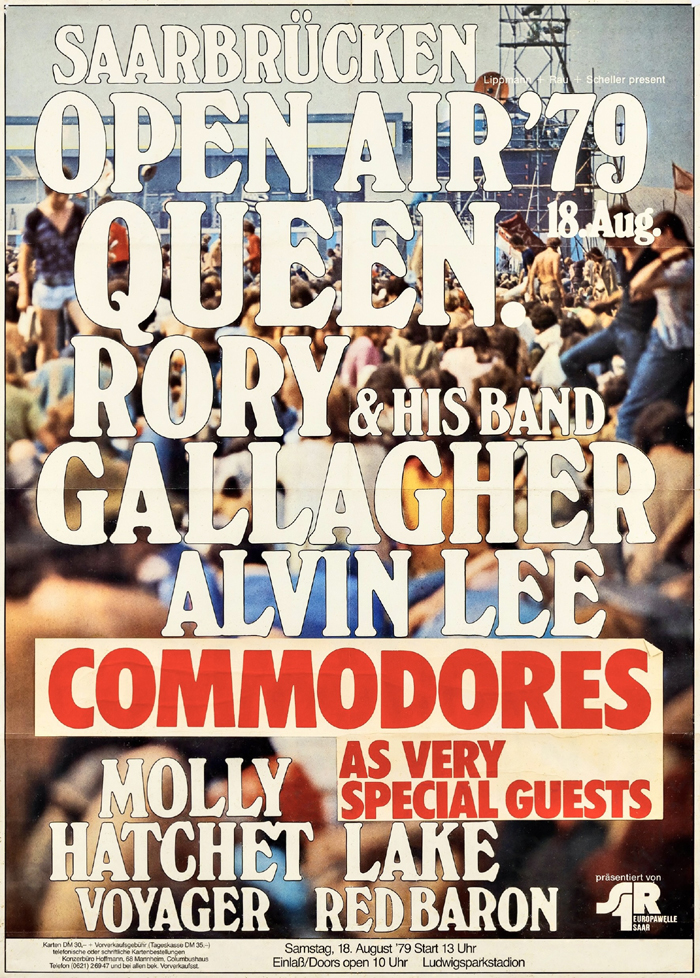
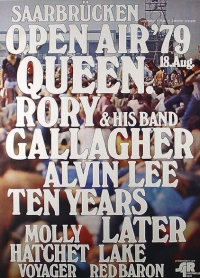
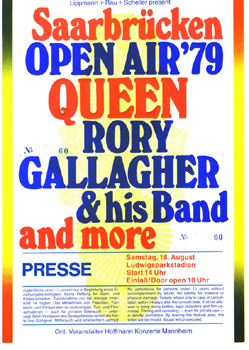
|
EXKLUSIV – INTERVIEW MIT
ALVIN LEE
Music
Scene

Part I -
Konzertbericht „Alvin Lee
& TYL“ in Winterthur, Switzerland,
August 24,
1979
von H. Raymonda
Im August 1969 überraschte
eine noch relativ unbekannte Band namens Ten Years
After Fachwelt und Publikum am dreitägigen
Woodstock – Festival. Vor allem der fünfundzwanzigjährige
Gitarrist Alvin Lee sorgte mit seinen
superschnellen Soli für Schlagzeilen. Das Weitere
ist Rockgeschichte: das Festival von Woodstock
wurde zum Mythos, und der gleichnamige Film darüber
verhalf der unbekannten Band Ten Years After zu
Superstar – Status und Alvin Lee zum legendären
Ruf, einer der weltbesten Rockgitarristen zu sein,
Zehn Jahre sind seither vergangen, und die Zeit
forderte ihren Tribut. Die Ten Years After nahmen
ein unrühmliches Ende, Alvin Lee machte ein paar
Soloalben, und nach einer zweijährigen
Schaffenspause formierte er seine neue Band Ten
Years Later.
Dies waren in etwa die
Voraussetzungen für das Konzert der Ten Years
Later vom 24. August
in Winterthur. Der Zufall wollte es, dass
dieses Open-Air-Konzert in der Steinberggasse fast
auf den Tag genau mit dem zehnten Jahrestag des
Woodstock-Festivals zusammenfiel. So war denn
manch ein Woodstock-Nostalgiker und alter TYA Fan
nach Winterthur gekommen, um sich für eine
Konzertlänge in die “gute alte Rockzeit”
versetzen zu lassen. Anzutreffen waren auch jene
Fanatiker, für die Alvin Lee nach all den Jahren
immer noch der „Grösste“ ist und die schon zu
Konzertbeginn „I’m Going Home“ verlangten;
sie hatten sich ganz am Bühnenrand postiert. Der
überwiegende Teil des Publikums waren
Schulentlassene und höchstens Zwanzigjährige,
die Alvin Lee erst durch sein Comeback mit Ten
Years Later kennengelernt hatten.
Zurück in die Zeit des Blues-Rock
Kurz nach 20 Uhr betrat die
Gruppe die Bühne. Zuerst der Schlagzeuger Tom
Compton und der Bassist Mick Hawksworth und
schliesslich Alvin Lee. Er ist noch immer der
blonde Hüne mit dem schulterlangen Haar, trägt
noch immer geflickte Jeans und spielt immer noch
seine mit Stickers beklebte Woodstock-Gitarre.
Etwas Bauch hat er angesetzt, und das Gesicht ist
leicht aufgedunsen, aber sonst hat er sich
wirklich nicht verändert. Gleich von Beginn an
legte er los, eine ungemein harte und rockige
Rhythmussection im Rücken.
Die Atmosphäre und Aufmachung des Konzerts
versetzte einen zurück in die Zeit Ende sechziger
/ Anfang siebziger Jahre, in die Zeit des
elektrischen Blues-Rock. Keine grosse Lightshow,
nur eine bescheidene Beleuchtung, keine Bühnendekoration
und künstliche Gags, nur das Nötigste stand auf
der Bühne: Verstärker, ein Gesangsmikrophon, ein
Schlagzeug. Und dann waren da drei Musiker, die
nur um der Musik und nicht um der Show willen auf
der Bühne standen. Ein Konzert in bester Jazz und
Bluestradition mit viel Improvisation und losen
Arrangements.
Die Begleitmusiker
Die neuen Begleitmusiker von
Alvin Lee sind gute Rockhandwerker, doch beide
erreichen nie den Standard ihrer Vorgänger. Nicht
dass sie technisch schlechter beschlagen wären,
doch sind beide ausgesprochene heavyrocker, denen
der Sinn für Dynamik und
für kleine stilistische Finessen
weitgehend abgeht. Der Drummer Tom Compton schlug
einen sauberen, brutalen, aber variationslosen
Beat, und sein Solo war monoton und viel zu lang.
Offensichtlich einen schlechten Tag erwischt hatte
der Bassist Mick Hawksworth, denn in regelmässigen
Abständen unterliefen ihm Fehler, und bei „I’m
Going Home“ war er mit seinen Kräften am Ende,
er konnte das horrende Tempo nur mit grösster Mühe
mithalten.
Seine schnelle, jeden Swing
vermissende Spielweise zerriss die ganze Musik der
TYL. Statt dass Mick Hawksworth mit einem ruhigen
Bassspiel die bei einem Alvin Lee dringend nötige
Ruhe in die Musik gebracht hätte, wollte
er seinem Chef punkto Schnelligkeit nichts
nachstehen und versuchte
dauernd, ihn zu überflügeln. Auch in
Sachen Sound könnte er von seinem inzwischen in
den Ruhestand getretenen Vorgänger Leo Lyons
einige Ratschläge gebrauchen. Seine Bassgitarre hätte
wohl einen guten Sound für Heavy-Metal-Rock
gehabt, niemals aber den weichen Ton für guten
Blues-Rock, wie ihn die TYA früher gespielt
hatten. Auf sein Solo hätte er ohne weiteres
verzichten können; es war ein langweiliges
schnelles Aneinanderreihen von Tönen, ohne
Einfall und Klasse.
Alvin Lee wie eh und je
Alvin Lee war von Anfang an
der uneingeschränkte Star auf der Bühne. Er
zeigte auf eindrückliche Weise, dass er von
seiner Schnelligkeit und seinem Können keine Spur
eingebüsst hat. Noch immer ist er ein blendender
Techniker und beherrscht seine Gitarre im Schlaf.
In seiner bekannten Manier entlockte er seinem
Instrument ein Solo nach dem andern, schnitt
Grimassen und Fratzen, sang und gebärdete sich in
seiner schnoddrigen Art wie eh und je. Von seinem
Charisma, das wohl in gleichem Mass zu seinem
legendären Ruf beigetragen hat wie sein
Gitarrenspiel, hat er überhaupt nichts verloren.
Und er vermag das Publikum nur schon durch seine
Ausstrahlung in seinen Bann zu ziehen. Wenn man
ihn so hörte und sah, konnte man glauben, er sei
erst gestern von Woodstock heimgekehrt.
Für viele zum ersten Mal live
Das Konzert war ohne Zweifel
ein Erfolg. Der schnörkellose Hard-Rock, dem zwar
über viele Strecken die Dynamik abging, fand beim
vorwiegend jungen Publikum grossen Anklang. Die
Mehrheit des Publikum erlebte Alvin Lee zum ersten
Mal live, sein letzter Auftritt in der Schweiz lag
fast fünf Jahre (Montreux, Alvin Lee and Co.),
der letzte in der Deutschschweiz gar 7 ½ Jahre
(Bern, Ten Years After) zurück.
Wahrscheinlich der grösste
Teil der Anwesenden kannte ihn erst seit seinem
Comeback mit Ten Years Later und deren Auftritt im
„Rockpalast“ oder bestenfalls vom zwölfminütigen
Ausschnitt aus dem Woodstock-Film. Für sie alle
war das von Alvin Lee Gebotene neu und die
erbrachte Leistung,
mangels anderer Erwartungen, gut bis hervorragend.
Weg des geringsten Widerstands
Für einen alten TYA-Fan, der
auch die Solokarriere von Alvin Lee verfolgt hat
und der die beiden oben genannten Auftritte als
Vergleichsmöglichkeit in Erinnerung hatte, war
das Winterhurer Konzert schlichtweg enttäuschend.
Mit der Gründung der Ten Years Later wollte Alvin
Lee dort weiterfahren, wo er mit seiner alten
erfolgreichen Band Ten Years After aufgehört
hatte. Der Grund dafür ist einleuchtend: Mit
seinen musikalisch erstklassigen Soloprojekten
nach der Auflösung der Ten Years After erreichte
Alvin Lee zwar gute Kritiken, aber nicht mehr den
erhofften Grosserfolg. So kam ihm die Erkenntnis,
dass die Kids „einfach
nur Rock ´n´Roll hören wollen“, die
zur Gründung der neuen Band führte. Diese
Einsicht hat schon viele alternde Rockstars vor
dem Untergang gerettet.
Grundsätzlich ist daran
nichts auszusetzen, hingegen ist die Art und
Weise, wie Alvin Lee sie in die Tat umgesetzt hat,
eher fragwürdig. Man wird den Eindruck nicht los,
dass er die erstbesten (und billigsten)
Begleitmusiker genommen hat und mit einem
minimalen musikalischen Aufwand noch einmal von
seinem alten legendären Ruf profitieren will. Was
er heute auf der Bühne bietet, ist mindestens
eine Klasse schlechter, als was er früher gemacht
hat. Die alten TYA-Songs werden zu einem Abklatsch
degradiert, den man als peinlich bezeichnen muss.
Sie werden fast auf den Ton genau kopiert (z.B.
„Good Morning Little Schoolgirl“, „Help me“),
mit dem einzigen Unterschied, dass die
Begleitmusiker immer im Schatten ihrer Vorgänger
stehen. Alle Soli von Alvin Lee hat man schon
einmal gehört, man hätte auch ohne weiteres an
der richtigen Stelle das entsprechende Solo ab
Platte einspielen können, so einfallslos kopiert
sich der gute Mann selbst. Eine Entwicklung, wie
sie bei anderen namhaften Gitarristen über die
Jahre zu verfolgen ist, ist bei ihm nicht
festzustellen. Von einem Sologitarristen in der
Sparte Blues-Rock erwartet man alles andere als
ein Rezitieren seiner auf Platten festgehaltenen
Soli. Die Improvisationen sollen von Konzert zu
Konzert differieren; sie leben von der Spontaneität
und Phantasie des Solisten. Davon war bei Alvin
Lee in Winterthur jedoch nichts zu spüren.
Rechnung geht vorläufig
auf...
Es ist klar, Alvin Lee ist
den Weg des geringsten Widerstands gegangen. Ein
Musiker von seinem Format hätte es nicht nötig,
mit zweitklassigen Musikern einen zweitklassigen
Aufguss seiner ehemaligen Erfolgsband dem Publikum
vorzusetzen. Dass er nach zum Teil hervorragenden
TYA-Alben auch zu anderem fähig wäre, hat er mit
seinen beiden ersten Soloalben „On The Road To
Freedom“ und „In Flight“ eindrücklich
bewiesen. Und an Konzerten mit Leuten wie Mel
Collins, Tim Hinkley und Ian Wallace hat er
gezeigt, dass es auch ohne TYA-Abklatsch und „I’m
Going Home“ geht. Aber warum sollte sich Alvin
Lee anstrengen, von Grund auf mit etwas Neuem zu
beginnen, solange er ohne grosse Anstrengung noch
weit besser von seinem Ruf als Woodstock-Legende
leben kann? Diese Rechnung mag vorläufig
aufgehen, denn das Publikum ist neu und will jene
Leute sehen, die Woodstock-Mythos damals gezimmert
haben. Aber spätestens nachdem es Alvin Lee &
Ten Years Later zum zweiten Mal gesehen hat, wird
auch das Publikum die Masche durchschauen. So wird
Alvin Lee, wenn er sich in der Zwischenzeit nicht
etwas einfallen lässt, nach drei bis vier Jahren
wieder so plötzlich von der Bildfläche
verschwinden wie er wieder aufgetaucht ist.
H. Raymonda
INTERVIEW
MIT ALVIN LEE, MICK HAWKSWORTH UND TOM COMPTON:
TYL
Am Tag nach dem Konzert traf
ich Alvin Lee, Mick Hawksworth und Tom Compton im
Restaurant ihres Hotels. Wohl keiner von den
restlichen Gästen ahnte, dass sich in ihrer Mitte
eine „wandelnde Rocklegende“ befand, Bier
trank und mit seinen Musikern und Crew- Leuten
Witze riss. Das Interview fing völlig verkehrt
an. Für diesmal wurde der Spiess umgedreht und
ich befand mich, ehe ich mich versah, inmitten
eines Kreuzfeuers von Fragen über meine Kamera ,
mein Tonbandgerät und weiss ich was. Nach viel
Gelächter allerseits war es dann an mir, ein paar
Fragen zu stellen. Wir kamen zuerst auf das
Konzert des Vorabends zu sprechen in.
Alvin: Das Konzert hat uns mächtig
aufgestellt. Es
was ein einmaliges Gefühl, auf einer Strasse zu
spielen. Ich sah Leute in den Fenstern stehen und
zuschauen, und da hat sogar einer die Haare
gewaschen und anschliessend im Takt gekämmt! Es
war erste Mal, dass wir als Strassenmusikanten
spielten!
Music Scene: Die Aufgestelltheit hat sich
offensichtlich auf das Publikum übertragen.
Alvin: Ja, wie manche Zugabe mussten
wir*** ? Ich weiss
nicht mehr, aber ich glaube, das lag daran, dass
die Cimerons nicht gespielt haben und die Leute
einfach nicht nach Hause gehen wollten. Aber die
Zugaben wurden verlangt, sogar als es anfing zu
regnen. Great! Man sollte mehr dieser
Strassenkonzerte
machen. Next year auf der Autobahn, huh?
Music Scene: War der Eintritt***
ein wenig günstiger
als an an*** grossen
Konzerten.
Alvin Lee: verschmitzt grinsend:
Na also, ich ***ete
JEDERMANN mit den Preisen! Ich glaube, wir waren
eine gute Vor-, Haupt- und Dessert-Gruppe. Wir
konnten auf diese Art viel mehr Stücke spielen
als sonst, wir haben auch gleich ein paar Neue
gemacht. Zum Beispiel die erste Nummer: noch
keiner von uns hat sie jemals gehört. Ich fing
mit etwas an und dachte hej, daraus kann man etwas
machen.
Music Scene: Entstehen auf diese Art eure
Songs?
Alvin Lee: Ja, zum Teil. Wir nehmen alle
Konzerte auf Kassetten auf und hören uns dann die
Improvisation später an. Das Problem ist nur,
dass sich ein riesiger Berg von Kassetten
aufstapelt, den wir dann „durchpflügen“ müssen. Mick Hawksworth: Es ist das
einzige Mal, dass man sich selbst hört. Wir
merken dann oft, dass wir ein Stück zu stark in
die Länge gezogen haben, und schneiden es dann
beim nächsten Mal so zusammen, dass die Höhepunkte
noch da sind, aber nicht unnötige Zeit
verplempert wird.
Music Scene: Kritiker kreiden dir an, dass
du immer die selbe Musik ohne Weiterentwicklung
gemacht hast.
Alvin Lee:
Dein Pulli ist zu gross
(allgemeines Gelächter). Ich meine, es ist
einfach, in der stillen Stube eine gute oder
schlechte Kritik loszulassen, ohne sich dabei um
die Meinung derer zu kümmern, die an die Konzerte
kommen oder die Platten kaufen. Die Musik hat sich
entwickelt, aber ich spiele deshalb heute keine
radikal andere Musik als in früheren Zeiten. Wir
spielen die Musik für das Publikum, und wenn das
Publikum nicht „abfährt“, würden wir das
sofort merken. Ich habe andere Musik gemacht, aber
mit „Energy Rock ´n´ Roll“ gibt es eine gute
Rückkopplung seitens des Publikums. Wenn man
ruhige Musik spielt, wird auch das geschätzt,
aber diese Energie kommt nicht vom Publikum zurück,
und schliesslich ist das unser „Gewinn“ von
Konzerten. Wir tun, was wir am besten können!
Music Scene: Was passierte mit den TYA
Leuten? Spielen sie in anderen Gruppen?
Alvin Lee: Nein, sie haben alle aufgehört.
Auf jeden Fall sind sie nicht mehr „on the road“.
Man kann nicht gut immer unterwegs sein und
gleichzeitig eine Familie haben. Sonst kommt man
eines Tages nach Hause, und man hat eben keine
Familie mehr. Ich weiss nicht, ob sie
Studiomusiker geworden sind, ich habe kaum noch
Kontakt mit ihnen gehabt.
Music Scene: Hat das et was mit dem
Auseinandergehen der TYA zu tun?
Alvin Lee: Wir gingen eine Weile vor der
Trennung auseinander, aber wollten das uns selbst
nicht zugeben. Niemandem machte es mehr Spass, und
die Energie fing sich an aufzulösen, obwohl wir
immer mehr Energie, schaffen wollten. Darum haben
wir (mit einem Grinsen und einem Seitenblick auf
Bassist und Drummer) das junge Blut hier!
Music Scene: Was passierte in den Jahren
zwischen Ten Years After und Ten Years Later?
Alvin Lee: Ich suchte neue Musiker...
Music Scene: ...man kann
nicht sagen, dass sich der Aufwand nicht gelohnt
hat, aber 3 Jahre suchen?
Tom Compton: Ich habe mein Telefon nie
abgenommen!
Alvin Lee: Nein, Ich habe in dieser Zeit
eine Menge Aufnahmen mit einer Menge Musiker
gemacht. Ich wollte etwas Heisses, Dampfendes machen. Aber die Musiker waren zu gut; wir
spielten, das Resultat war exzellent, aber eben
weder heiss noch dampfend.
Zu seriös, kein Punch.
Music Scene: Warst du müde vom ewigen
Auftreten?
Alvin Lee:
Im
Gegenteil, ich sehnte mich danach! Ich hatte aber
keine Band, meine Verträge waren damals in
Unordnung, und es gab Zeiten, da wünschte ich
mir, in einem Hotel zu sein und mich auf ein
Konzert, vorzubereiten. Aber ich wusste, dass es
mindestens ein Jahr dauern würde, bis alles
organisiert sein würde.
Music Scene: Hast du dein Studio in dieser
Zeit aufgemacht?
Alvin Lee: Nein, das war bereits vor
sieben Jahren. Das Studio war eine Riesenhilfe
beim Realisieren einer ganzen Reihe von Projekten.
Meine letzten LP’s sind allesamt dort
aufgenommen worden.
Music Scene: Wie heisst das Studio, und
wer hat ausser
euch dort aufgenommen?
Alvin Lee: „Space Studio“ ist der
Name. Es ist völlig privat, ich vermiete es
nicht. Wir üben darin; ein ganzes Jahr hatten wir
alles, was gestern auf der Bühne stand, im
Studio. Eine Reihe Songs, die beim Üben
entstanden, sind dann auch auf Platten
herausgekommen. Ich vergesse immer, welche Stücke
auf welcher LP ist, so kommt es vor, dass ich an
einem Konzert sage: wir spielen ein Stück von
unserem neuen Album, dabei ist es uralt. Es hat
also keinen Zweck, mich nach Titeln zu fragen.
Music Scene: Eure LP „Ride On“
verkauft sich in der Schweiz mindestens sehr gut.
Ist ein neuer Trend in Richtung Blues-Rock da?
Alvin Lee: Oh, das wusste ich nicht, wir
verfolgen die Verkaufszahlen nicht so. Aber das
mit dem Trend mag wohl sein. An allen grossen
Festivals sieht man Gruppen wie Queen und Genesis
mit fantastischen Licht- und Effektproduktionen,
aber man wird abgestumpft davon und bekommt genug.
Gruppen wie wir oder Rory Gallagher mit
Drei-Mann-Besetzungen hatten die grössten Erfolge
kürzlich in Saarbrücken. Was wir machen, ist
eben pure Musik ohne Explosionen oder Rauch oder
sonst was. Die einfachen Konzerte haben viel mehr
Effekt als die grossen Shows. New Wave hat auch
das Seine dazu getan. Die Leute gehen an
New–Wave–Konzerte und realisieren, dass es
sich eigentlich um Rock ´n´ Roll in einer rauhen
Form handelt.
Tom Compton: Es erinnert die Leute wieder
daran, dass es so etwas wie Energie auf der Bühne
geben kann.
Alvin Lee: Die Energie ist wohl da bei
New Wave, aber wenn es um Technik und Finessen
geht, ist nichts da, und wenn ein Solo kommen
sollte, kommt es eben nicht richtig. Es sind
jedoch fast durchgehend junge Leute, und sie
werden immer besser.
Music Scene: Ein Vorteil ist doch sicher,
dass die Plattenfirmen wieder neue Gruppen
„entdecken“ und somit etwas in der Szene
passiert.
Alvin Lee: Es passiert schon etwas. Die
Gruppen haben guten Produzenten, einen guten
Plattensound, aber wenn man sie dann live hört,
fehlen eben diese 16-Mann-Chöre und die 6
Snare-Drums und alles andere Gekünstelte. Aber es
ist auch Musik, die gehört wird. Und es ist
wichtig, dass etwas gemacht und auch gehört wird.
Deshalb bedanke ich mich immer beim Publikum für
ihr Erscheinen, ob sie nun wegen uns oder wegen
einer anderen Gruppe gekommen sind. Sie sind es,
die die Musik am Leben erhalten, ob sie nun
finden, dass diese oder jene Gruppe die Beste sei.
Music Scene: Aus welchem Grund wurde „Going
Home“ in vier verschiedenen Versionen
herausgebracht?
Alvin Lee: Tja, eines der Albums war
live, und live ohne „Going Home“ wäre eben
nicht vollständig. Auf dem Woodstock-Album waren
nicht wir bei der Auswahl dabei. Die anderen
Aufnahmen sollen zeigen, wie sich das Stück
entwickelt hat. Es verliert immer etwas, gewinnt
aber andererseits wieder dazu. Es ändert sich ständig.
Am Anfang war es ein Jazz-mässiges Stück.
Music Scene: Hat sich das Gefühl hinter
dem Stück verändert, oder besteht es überhaupt
noch?
Alvin Lee:
Für mich hat es langsam,
aber stetig geändert. Ich weiss nicht, ob das
ausser mir jemand feststellen kann. In einem
gewissen Sinn
ist es immer wieder ein neues Stück. Wir haben
den Rock ´n´ Roll-Teil mit uralten Rock-Stücken
angehängt. Der kam gestern früher als sonst! Es
ist nichts an ein Schema gebunden, die
Drei-Mann-Formation ermöglicht ein stetiges Ändern
ohne vorherige grosse Absprachen, Das Stück ist
unorganisiert. Es ist zwar grundsätzlich
arrangiert, aber wenn ich mich zu irgendwelchen
neuen Läufen entscheide, kommt eben bereits eine
neue Version heraus! Was „ Gefühl“
anbetrifft, was wir nicht haben, können wir dem
Publikum nicht geben und echt spielen können wir
nur dann, wenn die Reaktion der Leute uns zeigt,
dass wir ihnen das Richtige geben. Wenn das
Spielen einmal langweilig – für uns und das
Publikum – werden sollte, hören wir wohl
automatisch auf zu spielen.
Music Scene: Wieviele Teile hat das immens
grosse Schlagzeug?
Tom Compton: Bis gestern waren es 23 „Kübel“
und 13 Becken, glaube ich, aber da kamen die
netten Leute einer Firma an, die Becken herstellt,
und es dürften nun etwa 20 sein!
Music Scene: Braucht es so viele
Teile?
Alvin Lee: Er braucht sie nicht alle
gleichzeitig, das würde lächerlich tönen!
Tom Compton: Gewisse Toms brauche ich nur
im Schlagzeug-Solo, einige Teile brauche ich
weniger als andere, aber verwendet werden sie
alle!
Music Scene: Wir haben Gerüchte über ein
„Woodstock 2“ gehört. Was ist daran wahr?
Alvin Lee: Für mich ist Woodstock eine
gute Erinnerung. Wenn nun jemand hingeht und
dasselbe noch mal machen will, ist es für mich
nichts anderes als irgend ein anderes Festival.
Ich wurde wegen Woodstock 2 angefragt und
antwortete, dass wir mitmachen würden, wenn
irgend jemand Jimi Hendrix und Janis Joplin
auftreiben kann! Was es jetzt geben wird, sind
Erinnerungskonzerte, das ist alles.
Music Scene: Zurückschauend auf die zehn
Jahre seit Woodstock – gibt es bei dir das Gefühl
eines alternden Stars?
Alvin Lee: Kaum. Wenn mein Kinn noch ein
paar Zentimeter mehr durchhängt, werde ich mir
das überlegen. Natürlich wird man älter. Aber
solange der Drive immer noch da ist und die Leute
in den vorderen Reihen, die wir bei den Konzerten
sehen können, immer wieder dieselben jungen
Gesichter sind, gibt es für mich keine Veränderung.
Wenn wir einmal Mühe haben, Konzerte
„durchzuschleppen“, ist die Zeit gekommen, um
aufzuhören. Man überlegt sich zu wenig, dass vor
dem Rock die meisten Musiker, welche populär
waren, 40 Jahre und älter waren! Vielleicht
werden es bei uns nicht mehr 50,000 Zuschauer
sein, wenn wir einmal 50 sind, aber es wird immer
noch Arbeit geben.
Dave Th. Hutmacher
|

August 24, 1979 -
TEN YEARS LATER in Winterthur, Switzerland
Photos by Dave Th. Hutmacher - Contribution by
Christoph Müller
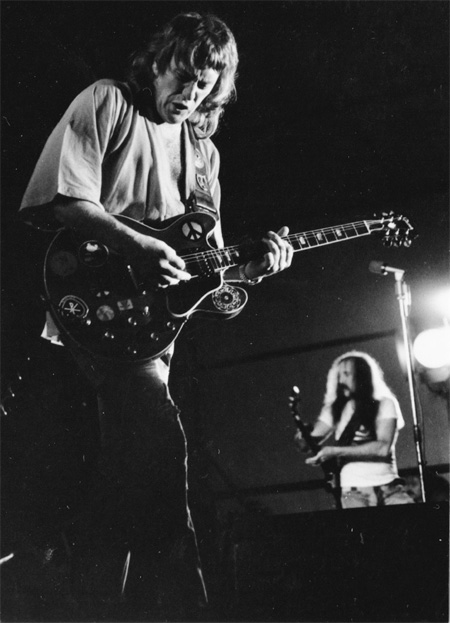

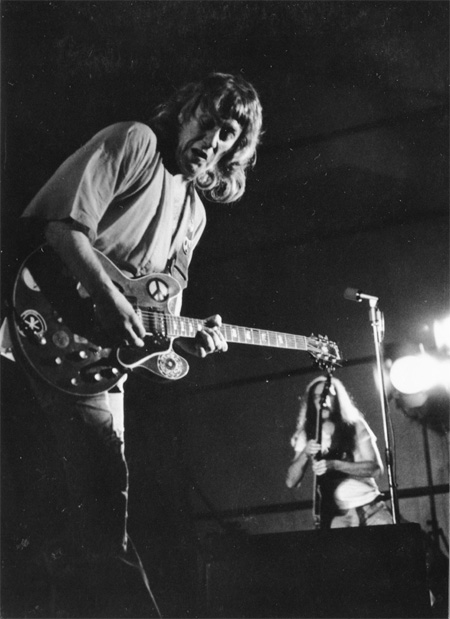

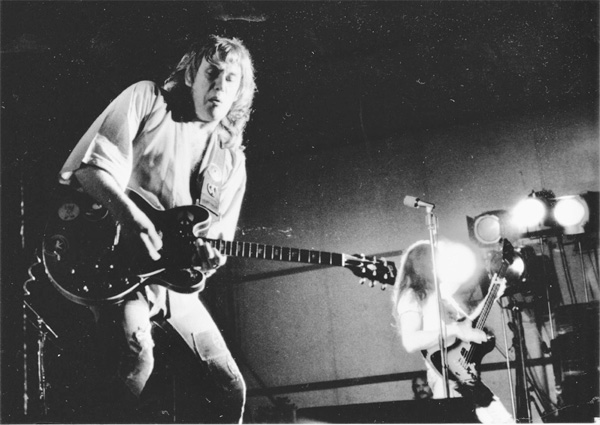
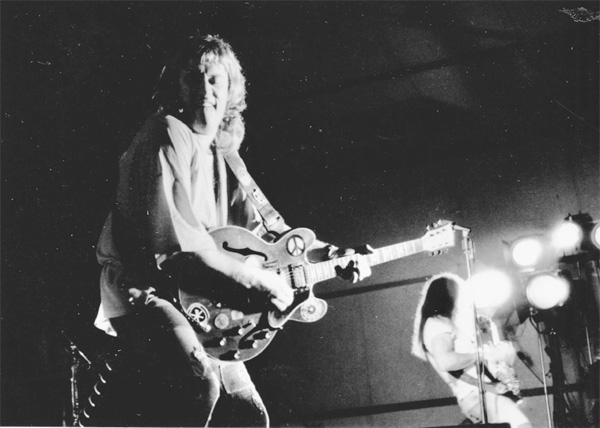


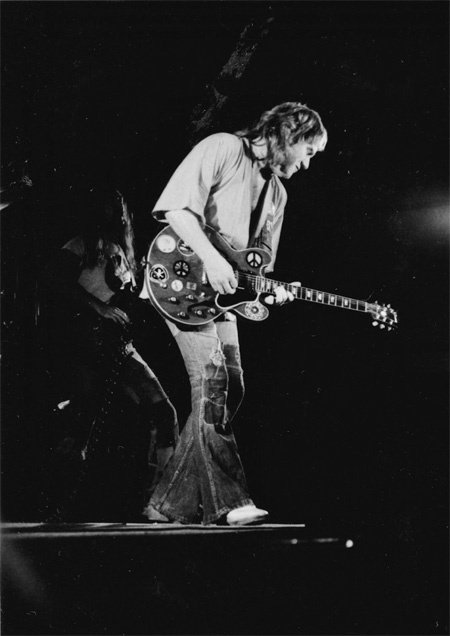
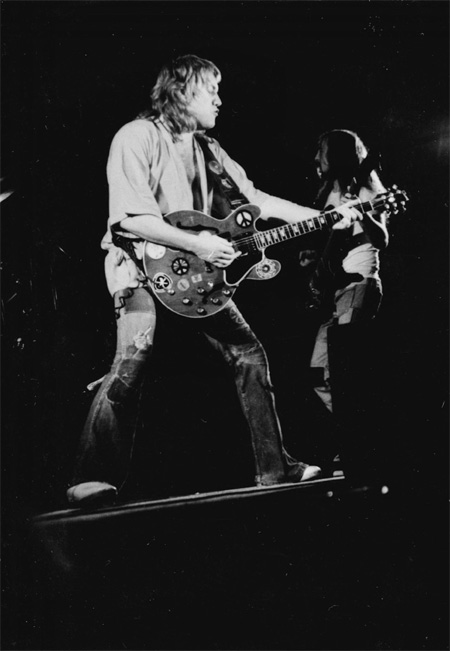
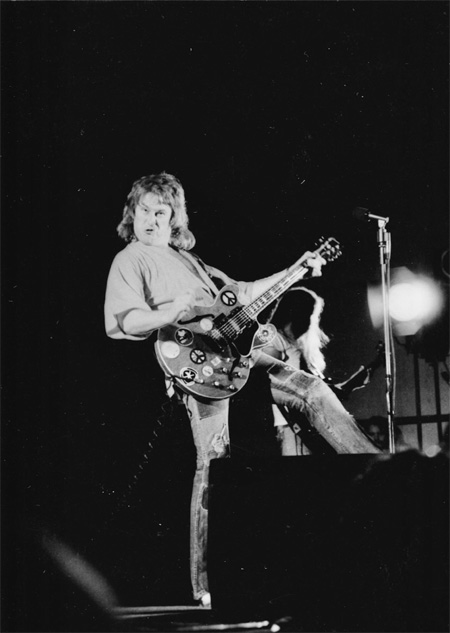
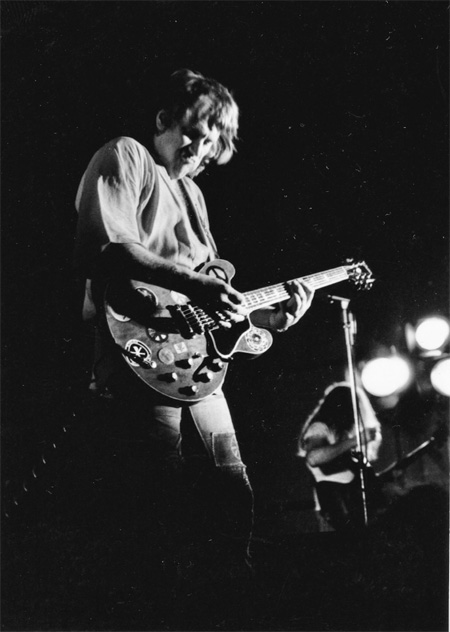
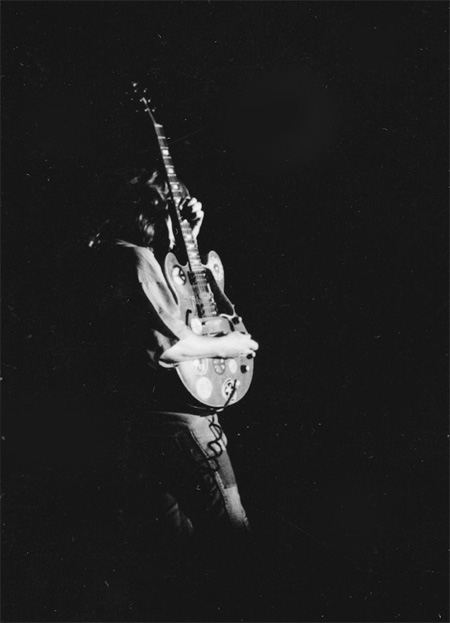
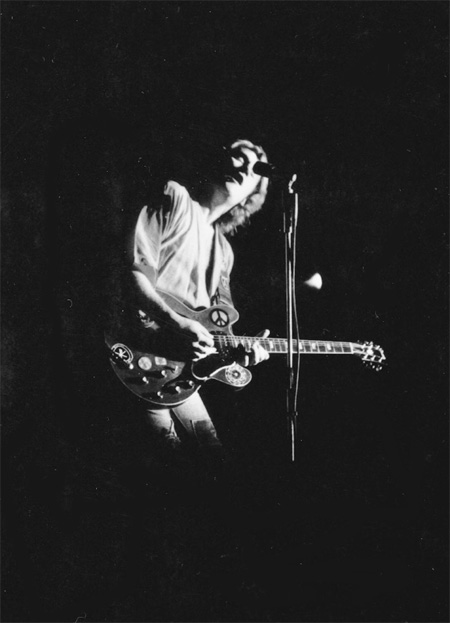
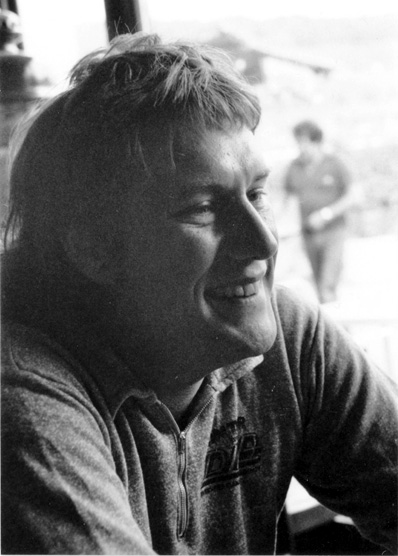
Alvin Lee in
Winterthur, 25 August 1979

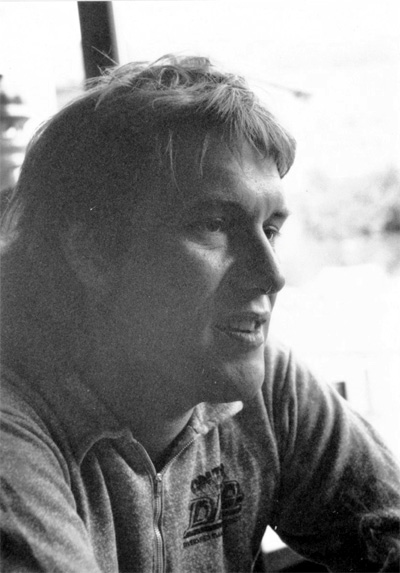
|
|
|
New Musical Express – October 13, 1979
Ten Years Later – A Month Later
Alvin Lee’s Ten Years Later called off their three
British concerts scheduled for this week at
Birmingham (Monday) Newcastle (Wednesday) and
London Hammersmith (This Saturday) within a couple
days of announcing them! It’s understood that the
gigs, which were reported in our last issue, are
being re-scheduled for November. It seems that Lee
wanted his U.K. visit to include an appearance in
BBC’s – 2’s “Old Grey Whistle Test” – and he can’t
get a booking on the show until November!
|
30
October 1979 - ROCK'N BLUES CONCERT
Neunkirchen am Brand, Hemmerleinhalle
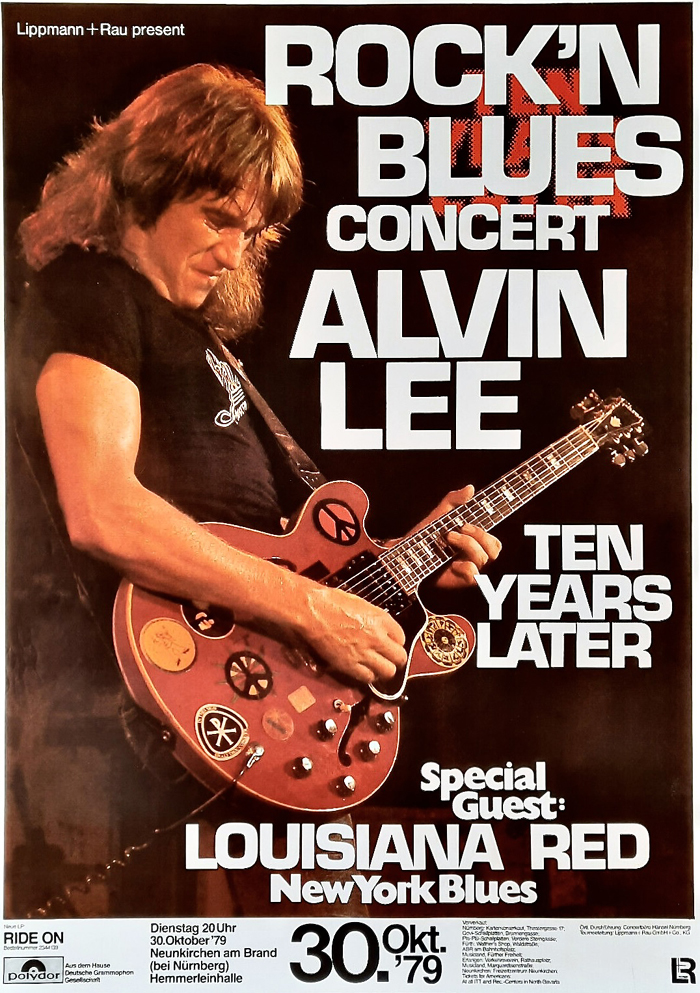
|
Ride On -
Overview 1978
This was
released by Robert Stigwood`s RSO record label,
1978’s “Ride On”, which is Alvin Lee’s
second solo comeback effort, always struck me as a
kind of strange coupling here. Best known for pop
and dance acts, singing Alvin Lee and his relatively
new band called, “Ten Years Later”, are definitely a
little bit outside of the company’s normal zone of
artistic comfort. It would be very interesting to
know what the behind the scenes scuttlebutt was
during this time period.
This was
produced by Bill Halverson, and the album offers up
a mixture of five new studio numbers, and four live
tracks. The album liner notes state the following:
“This is a true and faithful recording of Ten Years
Later on stage, no overdubs or effects have been
added”.
The live
portion of this recording is excellent, thanks to
drummer Tom Compton and bassist Mick
Hawksworth. Alvin Lee and friends, sound tight and
display more energy and enthusiasm than you’d find
on the last album release, by Ten Years After.
Ten Years
Later is what Ten Years After used to be back in
their hay-day.
On the live
side of this recording, it’s too bad that more notes
and information aren’t provided here. Such as times
and dates of performances. While the live tracks are
extraordinary, it’s the studio numbers that were the
big surprises here. They’re far more designed for
commercial consumption than I would expect from
Alvin Lee.
Side One – TYL In Concert:
- “Ain’t
Nothin´ Shakin´” – is so interesting for the
down-playing of Alvin’s blues-rock tendencies, in
exchange for a straight ahead rocker. Tight, and
in the best of taste – receiving top rating.
- “Scat
Thing” – some like it – many don’t. To me it’s
good…it’s a very short piece if you don’t care
this kind of thing.
- “Hey Joe”
– Jimmy Hendrix, over time hated playing this
song, but Alvin loved it and still plays it live
on stage. Alvin also gave it a good amount of
respect and an excellent going over on this album.
He gave the audience a view of his famous
pyrotechnics that couldn’t have been any more
impressive. The best part, is that you can really
hear Alvin enjoying himself through his guitar and
playing.
- “I’m
Going Home” – yes, the obligatory famous Woodstock
/ Ten Years After encore. This classic is well
done here, without all the fanfare and
circumstance. Makes you wish that you were part of
the audience and not just a listener here. It only
needs the visual aspect of it, to go along with
the audio effect.
Side Two – The
Studio:
- “Too
Much” – of what you want, is like getting too
little of something that you really need! A nice
little rocker in the true Alvin Lee style. More
of a roller than a rocker, but good start in
setting the overall tone.
- “It’s A
Gaz” – is a happy little love song, with a great
riff strolling through the entire song. Not for
head-banging, but for tapping your feet and
swaying in your computer chair.
- “Ride
On Cowboy” – is the most catchy and unique
number on this side of the album. It uses a
crafty mixture of reggae rhythm, with country
flavoured blues roots scattered through out.
It’s almost a funky country beat, and the song
is the highlight, and no wonder why RSO gave it
a four star single rating.
-
“Sitting Here” – is a slinky-greasy-rocker, with
power chords attached so that you can’t forget
that stick in your skull-riff. It’s also right
out of the Savoy Brown / Foghat play-book.
Sounds like a demo for commercial AM radio,
rather than a normal type Alvin Lee song.
- “Can’t
Sleep At Night” – ends side two of the album.
It’s a nice piece of boogie-rock and is a good
collection of new songs. It kept the continuity
of the album moving right along till the end.
Review by Scott Davidson |

Musicians Only – November 24, 1979
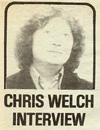 The Chris
Welch Interview with Alvin Lee and His New Band The Chris
Welch Interview with Alvin Lee and His New Band
Ten Years
Later – “Return of a Guitar Hero” A decade after he
first rose to fame
Alvin Lee is
back with a new band – “Ten Years Later”.
Tom Compton
and Mick Hawksworth
There comes
a time in a rock musician’s career when the clamour
and controversy that surrounded his early battles to
break through to the public, fades away and becomes
of little consequence. Alvin Lee has known
adulation, fame, money and the accompanying hard
slog that brought him from rhythm `n´ blues
obscurity in Nottingham, to rock `n´ roll fame on
the international stages of rock. Alvin did it all,
and he did it first, almost according to the Rock-Star
text book. Big – Money tours of America, rows within
Ten Years After, the eventual split and retirement
to the country mansion. It’s a familiar saga, except
that Alvin, throughout it all, has remained simply
and genuinely, a nice bloke. There is not a whiff oh
egocentricity about the man, hailed as a guitar hero
alongside the Claptons, Becks and Pages.
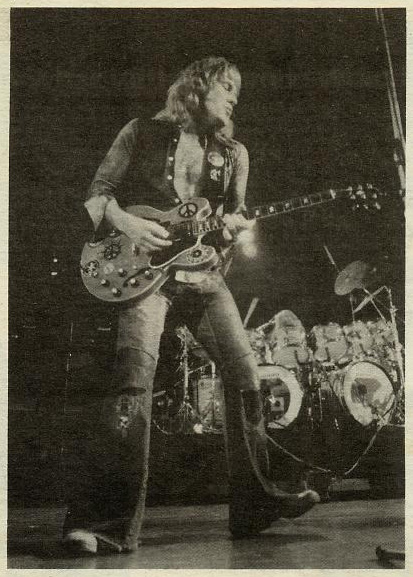
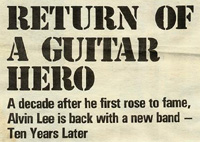
Alvin had a
natural gift for showmanship, which stays with him
today and his guitar technique remains dependable
and at times dazzling. For the last couple of years
he has thoroughly enjoyed himself with a new band,
called “Ten Years Later”, proving that he is not
content to rest on his laurels. He’s done it once,
and now he’ll do it again. And despite a brief
flirtation with country rock, and a big band in the
mid seventies, he’s happiest with a tight little
trio, playing essentially, the same guitar style
that brought him to fame in 1969.
Like most
musicians, of his generation, Alvin Lee intends to
“Bop” until he drops.
The new line
up features, Tom Compton on drums and Mick
Hawksworth on bass guitar, and between them they
have built up and exciting wall of sound. Alvin is
obviously delighted with his crew. Their enthusiasm
brings out the best in the guitarist, who admits he
might tend to lay-back and make things easy if it
were not for their drive. Tom in particular is a
source of considerable energy, and his solo on a
massive showpiece drum-kit, is one of the highlights
of a two hour barn-storming set.
Until
recently, the band have achieved their greatest
successes abroad, gigging extensively on the
Continent and in America. Now they are embarking on
their first British dates, although they did some
warm-ups during the height of Punk-Mania, when they
were mistaken for the Sex-Pistols. Well, that’s
their story. They told me the full story of their
development and high hopes for the future down at
Alvin’s pad, in secluded Berkshire acres. He lives
not far from George Harrison’s famed Henley Mansion,
and George and Eric Clapton are occasional visitors.
They once recorded a jam session in Alvin’s home
studio called, “Too Many Lead Guitarist”, which Eric
played over the P.A. System on his own tours.
The studio
was built by Alvin with the help of his father,
inside an old barn, and the ancient beams, riddled
with worm-holes, but cleansed of all living
organisms, are still on display inside the
comfortable control room, and the length of the
spacious studio. Here I had the chance to check out
the band’s instruments including the vast Compton
drum and cymbal plantation. “KIT” seems hardly an
adequate description. But first we talked inside the
house, where Alvin also demonstrated the latest
German toy sports cars for our further amusement.
To
back-track, what happened to Alvin’s house desire to
work with bigger groups?
“I wanted to
do it at the time, in an attempt to get away from
the stuff I had been doing with Ten Years After. But
it served its purpose and made me realise that
really I was happiest with a smaller group. It was
the music I liked, but more that I liked to listen
to, than play myself.
I didn’t get
enough excitement out of it, and wanted a “Heavy
Rock `n´ Roll Band”, and here they are. “We’re
celebrating our second anniversary, and with any
luck, 1980 should prove to be our big year”. They
explained, they are attempting to expand their
horizons on their next and third album, which they
are currently recording. The most recent, is called
“Ride On” (Polydor Records), combines both studio
and live performances. Now they want to develop
their song-writing, and leave the rave-ups for stage
work. “It’ll be day-time music,” said Alvin. “Until
now, we’ve been establishing the fact, that we are a
heavy-weight rock band, blasting it out. But from
the number of gigs that we’ve done, and the live
side on the album, we’ve firmly established that,
and we want to branch out and experiment in the
studio.
We’re going
for moods and restrained power. People don’t want to
buy an album featuring just forty minutes of
thumping beat. “A song like “Ride On Cowboy” has a
nice loose feel and a spare guitar sound, which
everybody likes as a possible single. The trouble
is, I don’t think the band has an image in Britain,
because we’ve worked so much abroad. I think it’s
important that we should have one, although I didn’t
when we started. I always shied away from having a
kind of pop image, and ending up like Rod Stewart or
someone. Mind you, I notice the Apple scruffs don’t
hang around George’s house anymore!” What were they
doing about the image building at home? “Well, we’re
playing at the Odeon Hammersmith on November 28th
and other dates at Birmingham, Leicester, Newcastle
and Bristol and they will be the only ones we’ve
done here, apart from the six gigs when we were a
“Mystery Guest Artists”. People thought we were the
Sex-Pistols, and might spit on them. They were going
around doing the same thing at the time, and all the
audiences were waiting for the Sex-Pistols. So, I
swigged a pint of water and spat all over them. They
were quite horrified!
But the
punks got off on rock `n´ roll and enjoyed it. It
was at the height of the punk publicity thing and
everybody was getting quite scared about it. But we
went out to play and it was just the same as always,
except they dressed differently. We were all punks
once you know, I know I was”. Said Mick Hawksworth,
“We thought the kids might say “Oh, here comes Alvin
again. Yawn”. But I was absolutely amazed. Before we
went on, the kids were rushing the stage”. At one
time, the band were looking for a fourth member to
play keyboards, but eventually they realized they
were much tighter and happier on their own. “Even
with the best keyboard player, there would be no
room for him,” opined Alvin. “After our desperate
search, we rather horrified ourselves by deciding to
stay a three piece”. “That was the day we made a
pledge, that we would be like the “Three
Musketeers,” said Tom. “We like to keep on our
toes,” said Alvin “I’m always very conscious that we
shouldn’t play the same numbers, the same way every
night. We often make up numbers while we’re on
stage, and you can tell by the faces of the road
crew, if they are digging it and whether it’s
happening. “It’s all very difficult now-a-days. Just
the cost of running a band makes me wonder how new
bands can break through. We travel light, and have a
tight crew, but a P.A. and lights are basic
necessities, and not luxuries. Our albums are doing
pretty good, but album sales are down by 50% all
over the world, so we’re about average, and we’re
keeping our heads above water”.
One constant
companion with Alvin over the years has been his
Gibson guitar and 50W / Amp. “The guitar is an old
ES-335 that’s 21 years old, and called “Big Red”.
It’s covered in stickers from the psychedelic
sixties. I sent it back to Gibson and they varnished
over them, so they are there for ever, which is
rather nice. The neck broke, so I sent it to
Kalamazoo for a new neck. It took six months, but
they did a very good job. I bought it in Nottingham
for 45 pounds – with case! It was a good investment.
“I’ve got quite a big collection of guitars, and
when I was playing with the nine-piece band, I used
quite a few different guitars to produce different
sounds. “But my gimmick now is that I don’t have any
gimmicks at all. No fuzz boxes or pedals, just
me-old guitar going straight through the amp, which
is unique now-a-days. I use a 1958 50 / Watt
Marshall amp. The 100 / Watts were a touch louder,
but a bit harder and didn’t sound so nice. I even
tried the new 50’s and they didn’t sound right.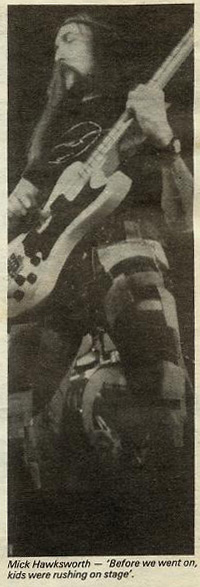
“A guy from
Marshalls came down. He’d been working at Marshalls
for ten years, and he looked inside my amp and said,
“I’ve never seen one of these before”. It was just a
little capacitor on one of the inputs, which made a
difference, and I asked him to put one on all my
amps. It drives the valves hard and makes the note
sing and the sustain is much better, which is good
for the guitar. It’s not a hi-fi situation. If you
played my guitar through a big set up, it would just
sound like a violently loud banjo. You’ve got to get
sustain through the guitar amp.
But Mick is
the man to talk to about technology. He’s the only
one who can switch his amplifier on”. Mick uses
three bass guitars on stage, including a double-neck
built for him by Peter Barraclough which weighs half
a ton, but produces all kinds of exciting effects.
“I’d use it all the time except that half way the
set it does get a bit tiring,” said Mick. “I also
use a Gibson RD-Artists Bass, a 1963 Gibson
Thunderbird, and a Guild 301 Bass”. The RD-Artists
Bass, is the one that Mick inevitably tosses into
the air at the end of his solo, with a dramatic if
dangerous flourish. Mick has been known to hit the
steel girders above the stage with his bass and once
broke the neck off of his beloved Gibson Artists,
but he says: “I don’t really like breaking
instruments, I don’t go along with that. Usually, I
can catch it”! “I used to throw my Gibson across the
stage, so fast it would skim and bounce,” recalled
Alvin fondly. “I did it every night for about three
years, bang, bang, bang. Then one night it broke,
accidentally. I felt a bit embarrassed. The guitar
repair man told me, “If you put a maple neck on,
they bounce better”. He knew all about it. I wasn’t
fooling anybody”.
We adjourned
to the studio, and examined the gear, and it has to
be said, that pride of place, went to Tom Compton’s
mighty drum-kit. It was a Ludwig Blue Oyster Pearl
kit, the components have been built up over the
years and date from 1965 to 1970. It’s comprised of
the following: Two 22 x 1in Super Classic Bass Drum.
Two 14 x 15 in brass shell 400 Snare Drums with
Rogers “Dynasonic” snare beds. Six 8 in and 10 in
custom tom-toms using Ludwig fittings; five Ludwig
Super Classic tom-toms. 12 x 8 – 13 x 9 – 14 x 10 –
16 x 16 and 20 x 18 in, with Remo Pinstripe and CS
heads; 16 and 18 in Remo Rototoms and Perspex
reflectors; one pair custom brass shell 14 in
timbales, and a set of Tama Octobans (8); two Rogers
high-hat pedals and two Rogers “Swivomatic” bass
drum pedals with chain conversions; one Bell Tree,
Au-Go-Go bells and various cowbells. Cymbals: 22 in
heavy ride Avedis Zildjian, 20in Sound Creation Dark
China (Paiste), 20in Paiste Sound Creation Dark
Crash, 18in short crash, 16in 202 Marching, 11in 202
splash, pair of 15in 202 sound edge hi-hats, 22in
China type, one set cup chimes, 17in Paiste 602
sizzle, 18in medium crash, one pair 8in 602 hi-hats,
one 8in bell, and 8in splash one 36in symphony gong
and stand. And Tom plays the entire lot, sitting
down! I had tremendous fun attempting to play this
lot, and the Octobands in particular sounded superb
while the tom-toms thundered like the crack of doom.
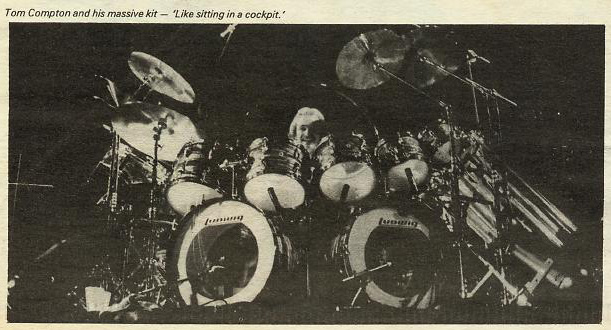
Climbing
into Tom’s kit is rather like boarding the cockpit
of a Boeing 747, but much more exciting. How long
did it take to set up the entire shebang? I
wondered. “About an hour,” said Tom gazing with
pride upon his beauties. “And it all has to be in
the right place every night.
If something
is out, it rattles. “I’ve had a large kit for many
years, and I’ve always liked the idea of a range of
tom-toms. In fact these Ludwig drums are very old,
and I made some of the tom-toms up myself, out of
Ludwig spares, but they match the old Ludwig
colours. I have a total of 29 drums and 22 cymbals,
nearly all Paiste including a lot of their new
range, the Sound Creation. When I went to the Paiste
factory, they were extremely helpful, showing me all
the latest cymbals. I’ve got splashes, sizzles,
rides and crashes. You can give one almighty wallop
and hit all three cymbals at once! It gives a nice
tonal range, and the good thing about having so many
drums, is that everything resonates with it and
gives such a good sound.
You get a
huge live sound. It’s like sitting in a cockpit, and
everything is handy”.
Tom’s
enthusiasm is symbolic of “Ten Years Later” who
prove that experience and commitment are still an
unbeatable combination. “If we do make any mistakes,
we like to pretend that’s what we intended all
along”. Explained Tom. Alvin and Mick laughed.
“That’s what I do all the time,” said Alvin.
|
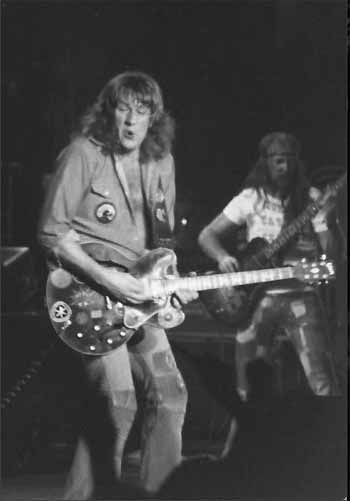
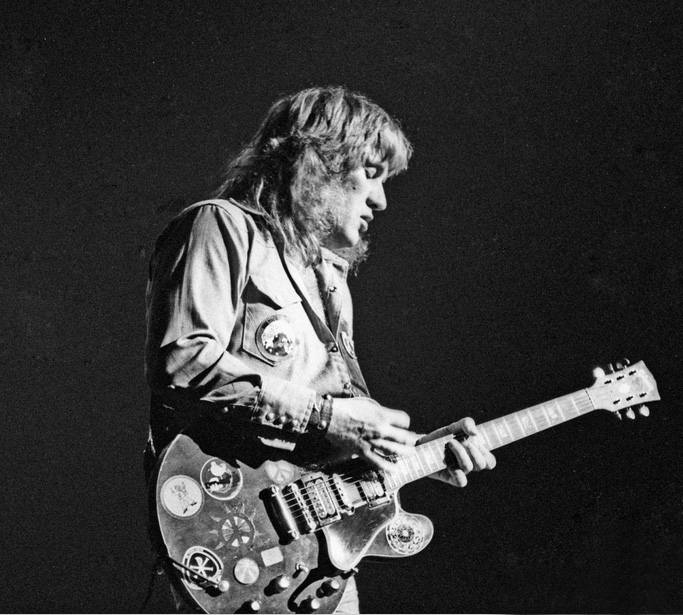

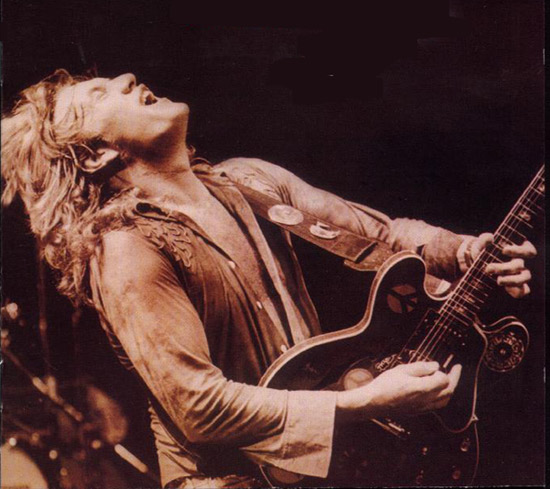


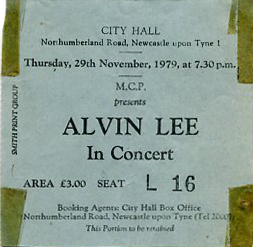
|

Melody Maker
– December 8, 1979 – After Dark Section
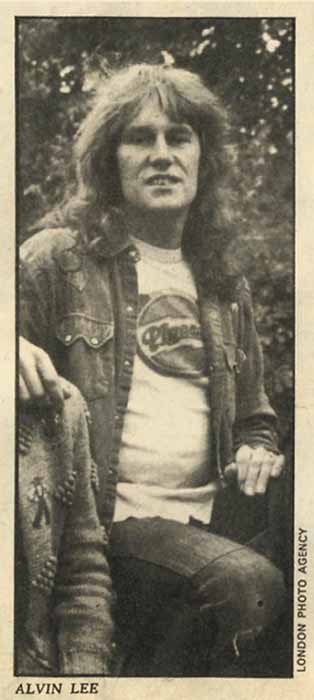
“I’m a fish
and chips musician, not a lobster thermidor,” said
Alvin Lee. ”When I’ve been off the road, I’ve found
myself saying: “If only I could be in a Holiday Inn
tonight!” It’s taken a few years to sink in, but now
I’ve decided that touring is the natural life, and I
never want to stop being a working musician. I look
at Muddy Waters and John Lee Hooker and say to
myself; Yeah, they’re still at it, and that’s for me
too”.
The speed-freak of Woodstock as he describes
himself during our meeting, is back on the road with
a re-formed trio under the name Ten Years Later. Lee
earned a fair reputation for dazzling technique with
his band Ten Years
After, in the acid and post hippie period of British
Rock, but now like many others doyens of the Old
Guard, he’s hoping to persuade younger fans that he
can play a better game than most of the younger
bands.
He’s 34 and lives in some grandeur in rock’s
stockbroker belt of Hanley on the Thames – Oxfordshire.
But for a long time he wondered what to do with the
rest of his years and eventually realised that life
on the road was the answer. “I want to seek the
highest of highs and the lowest of lows. That’s the
touring life, and I want it back,” he says. “I
intend to be doing it when I’m 40 or 50. Sure, to
continue doing what I’ve always believed in,
musically and physically get’s harder the older I
get, but my heroes are the blues musicians and they
seem to continue going round the world with a
certain dignity”.
He built a
sixteen track studio at his home, where he recorded
his new album “Ride On” and he formed a new trio
with Tom Compton (drums) and Mick Hawksworth (bass).
“I tried a keyboard player,” he says, “but honestly,
he gave us no room to play. I wanted a simple and
honest approach to rock `n´ roll blues, but we all
agreed that the pianist was shaping the overall
sound far too much. He had to go, because there was
no way I was going to put up with that drone”. Ten
Years Later approach their current British dates
with plenty of confidence. They’ve recently
completed a successful European tour, and an
American tour last year proved that the legend of
Woodstock is still alive.
The Alvin Lee of today is
under no illusion about his relevance to the new
rock audience. “We’re all getting on, the musicians
who made it in the Sixties and Seventies, but I
definitely think there’s a place for us. It’s great
to see the new bands coming up, but that whole scene
has got to sort itself out, and I notice it’s still
only the good players who are getting anywhere”. As
a warm up to his recent European tour, Alvin went
out on a few gigs into small halls “full of safety
pins and audiences expecting the Sex Pistols”. At
one in Leicester, he says he drank a lot of water
and spat it out at the audience to demonstrate how
unpleasant he thought the habit was. “They were
horrified and I suppose as much as anything, by the
sight of this old musician joining in on their
scene”. The music he says, went down well, and he
has always enjoyed, “tough, sweaty, gigs”.
He feels
that in the future the enormous arena concert will
become “obsolete”. “I just don’t believe that we can
go on forever playing to audiences the size of
Madison Square Garden, or even Wembley and expecting
it to be a real rock concert. The economics of rock
music today will probably prove me wrong, but I like
the atmosphere of a place the size of Hammersmith
Odeon, where the musicians get off on the crowd and
vice-versa. It’s just the right size. I’ve had it
with places the size of Madison Square Garden, where
the crowd is a dot and the music is one long echo”.
He holds strong views too, on performers obligations
to play all their old hits, anything the audience
demands. “When we’ve been touring recently, and last
year in the States, I sat down one night and had to
face the fact, that if I went to see Jerry Lee
Lewis, I’d want him to do “Whole Lotta Shakin”. I
guess there’ll always be some people out there
wanting me to play “I’m Going Home,” and that’s why
they come to the show in the first place. They’re in
love with a memory of an event that took place
earlier, of something. So I reckon
every musician has to go back to his roots and give
the audience whatever it was that dragged them out
from their houses to the concert hall to see him in
the first place.
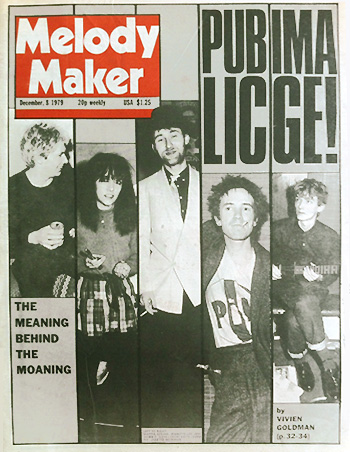
He knows
though, that his road back to a British audience
won’t be as simple as turning on a tap. “We had
great years with Ten Years After and made lots of
mistakes, but I’m determined to learn from them. I
don’t want to fall into the same traps. As I’m
intending to keep playing for as many years ahead as
I can imagine, I have to forget all the nonsense I
grew up with in the early Seventies. “I don’t
believe at all in the champagne and limousine at the
airport trip anymore, and I’m not into fifty foot
tanks with sharks in the dressing room. That should
all stop. No promoter should stand for it, and once
a band experiences that kind of treatment, they
expect it again and again and the whole thing became
ridiculous . The promoter is not a catering officer.
He should get the gig together and make his act
(he’s promoting comfortable) and that’s all. “What’s
brought me back with such enthusiasm is my honest
belief that rock `n´ roll is the bridge between the
50 year old musician and the 12 year old kids. For
me, it still has that power. “Sound-Check hassles
and motorways are like a drug to me, and I want to
be out there taking it”.
Article by Ray Coleman |
|
|
|